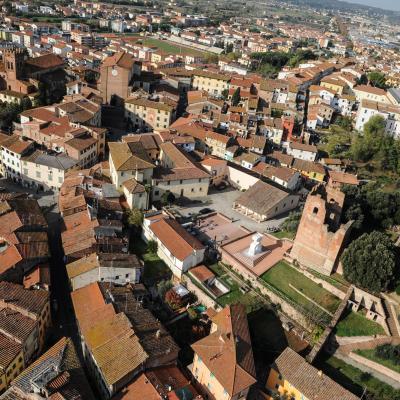The picturesque Corsini Park, with its ancient buildings, is located in the heart of the historic centre of the town. The area includes the palace, the medieval towers, the park and a series of buildings joined by common spaces.
The palace and the contiguous fortified area of the fortress - in the 11th century - was already home to Salamarzana Cadolingio's castle - initially held different and separate events. The first functional unification of the two areas occurred in the early 15th century when the buildings and fortifications came under the control of wealthy Florentine families. In 1460 the palace, already the administrative center of a farm, was purchased by Giovanni di Cosimo dei Medici, and then passed to his nephew Lorenzo the Magnificent and finally to the hospital of Altopascio. The phase of Medici property dates back to important renovations that have given the building the current appearance. In 1643 the farm was purchased by the Marquess Corsini who in 1864 also became masters of the Rocca. Since 1981 the entire complex has returned to municipal ownership.
The Museum, the Municipal Library with the Historical Archive, the Auditorium La Tinaia (home of the Sottosopra Youth Centre), the Centre for Performing Arts "il Frantoio" and the former Limonaia are located within the area.
The Palace
The Palace, which is accessed from Piazza Vittorio Veneto, is divided over three floors and ends with an elegant side covered porch supported by brick columns. Built on the oldest Castellane walls, the building included a door that opened onto the "square" (now Piazza Niccolini) and which connected directly to the main villages. Inside the building there are still traces of previous medieval buildings, being formed by at least two bodies joined during the renovations of the 15th century. On the first floor, in particular, there is a decorated terracotta arch, a fragment of a 14th-15th century fresco and some decorated paintings (landscapes and framings) designed by Stefano Fabbrini in the second half of the 18th century. The main building is connected by two wings formed on the premises once used as services of the Farm and which today house the Library, the Historical Archives and the Civic Museum.
The park and the Rocca
From the palace you can access the park, where the towers of the Rocca dominate a forest of oaks, holm oaks and cypresses. The fortification, willed by the Florentines in 1322, served to play a controlling role on the important Fucecchian crossroads and the bridge over the Arno, as well as to rein in the restless local population by suppressing its frequent uprisings.
Intended for military use until the 14th century, the fortification lost its original strategic importance in the early 15th century, after Florence, conquered Pisa and consolidated its frontier to the west. Dominated by the majesty of the "Torre grossa” (Big Tower), what remains of Salamarzana Cadolingio's oldest castle, the park is also home to the high "Torre di mezzo” (Middle Tower) and the smaller "Pagliaiola" which stands on the eastern side.
Panoramic point of the Torre di Mezzo
In December 2021 the panoramic point on the top of the Torre di Mezzo was inaugurated, born from the insertion inside the structure of an iron staircase and some balconies that allow a view from above of the Arno valley. The project, definitively approved in 2018, was co-financed by the Region and the Municipality of Fucecchio and is located along the route of the Via Francigena (Fucecchio is the leading municipality of the central-southern Tuscan aggregation) enhancing the ancient route of pilgrims. The intervention has not only a tourist value but also has the aim of preserving one of the ancient towers of Parco Corsini in the best possible way, through seismic consolidation. The Torre di Mezzo after a few centuries returns, in a certain sense, to its original function: once a fundamental sighting point for the defensive strategies of the Rocca Corsini and the Castle of Salamarzana, today a panoramic point to admire the Arno valley look towards the Rocca di Federico II in San Miniato.







